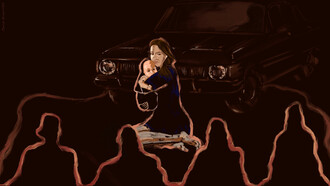Perfection is an illusion… but I want that illusion.
The power of youth is perhaps the most coveted of earthly commodities, as beauty is no longer a reflection of nature’s rhythms, but rather a standard constructed by digital distortion and cosmetic intervention. In this complex modern age, the paradox is unmistakable: the more we relentlessly quest after eternal youth, the further we slip away from the natural beauty we so desperately seek to preserve. I’m not talking about the occasional lunchtime botox and filler, upper blepharoplasty and facelift that many women and men get done after their 40s, nor am I criticising those who invest and indulge in beauty treatments (and procedures) that leave them feeling better, more confident, and self-assured. I’m exploring a more sinister and severe case of beauty dystopia for a generation obsessed with the erasure of time.
We have grown to fear ageing as if ageing itself were an insult to our human spirit. Yet, in our pursuit of looksmaxxing—from collagen glass skin to fox eyes to filled lips to snatched jawlines to glossy satin-wrapped hair and upturned pixie noses, we have inadvertently placed a price on imperfection, trapping ourselves in a cycle of self-reinvention that only leads to burnout. This relentless pursuit of youth is not new, but the methods have evolved—what was once celebrated as wisdom with age has now been transmuted into something we scorn. Under the weight of illusory ideals, signs of ageing are increasingly seen as flaws to be concealed and most interestingly, repaired. In this dystopian beauty culture, we are told to be ageless and perfect, but in doing so, we risk losing the essence of what makes us truly beautiful: the inexorable passage of time.
The illusion
The social media revolution of the 21st century has birthed digital worlds like Instagram and TikTok that have entirely transformed beauty from an individual expression to a collective obsession. In this mass experiment, the goal isn’t to just look gorgeous but to look like an ideal that’s almost indistinguishable from artifice. With the convergence of fast fashion and the ever-shifting face of microtrends—whether you’re coquette, a mob wife, old money, or an office siren—'overconsumptioncore’ and its pervasive hold over the beauty space have us in a literal chokehold.
From plasma fillers and blood-soaked vampire facials to stimulate collagen to mouth tape and face-lifting sleep straps to reduce recessed mouth-breather chin to silk hair bonnets to stop breakage and split ends to high-frequency micro-electric glass massage comb and organic rosemary oil to stimulate hair growth to baby botox and lip flips and filled cheeks and PDO threads and Sweet Sixteen rhinoplasties to SPF50 lathered faces (don’t forget even in the winter!) with medical-grade prescription-only acids for perfectly smooth glass skin.
Every trend drives a new algorithm that rewards perfection and a sense of beauty increasingly tethered to an unattainable illusion—we are so fixated as a generation on preventing ageing before it even starts. Even in writing this, I remain acutely aware of my own beauty consciousness. Just like the rest of my generational cohort, I too fall prey to the irresistible and unquenchable pull towards the symmetry and satisfaction of absolute perfection.
In the mirror of the digital age, we are all sculptors, and our faces are works in endless progress.
The paradox
In the pursuit of timeless beauty, we risk becoming strangers to our own faces. This is the irony at the heart of our pursuit of agelessness, particularly through temporary cosmetic treatments like filler and the fatigued appearance we are seeing many young celebrities develop from overuse. The very fillers designed to plump and add volume to imbue our faces with a youthful veneer instead create an uncanny, overfilled appearance also known as ‘pillow face’. The more we sculpt and refine, the more the face loses its natural shape.
Cosmetic professionals are now guiding young clients through reversal journeys—filler detoxes that attempt to peel back the layers of this synthetic self and reinstate the face to what it once was. In Hulu’s The Kardashians, Kylie Jenner openly discusses her recent decision to dissolve her fillers after starting them as a teenager, only now realising how slippery the slope of injectable upkeep is—a permanent binding that is too often overlooked and almost always regretted.
Death becomes her
Death Becomes Her, the 1992 cult classic starring Meryl Streep, Goldie Hawn and Isabella Rossellini, remains a haunting allegory of Hollywood’s enduring obsession with eternal youth and how women are not allowed to age. Madeline, a fading actress grasping at the scraps of her former fame along with Helen, once overweight and ridiculed, both find salvation in the Elixir of Eternal Youth, offered by the immortal and elusive Lisle von Rhuman. Yet, their deal with the devil comes at a grotesque cost—their hearts may beat forever but their bodies decay, ultimately betraying the youthful perfection they sought to immortalise. The film’s sharp satire dissects the cosmetic surgery industry through Ernest, their spineless and weak-willed plastic surgeon caught in their web of vanity and vengeance, and remains their lifelong fixer-upper. The interdependent entanglement between Madeline, Helen and Ernest mirrors the realities of our dystopian billion-dollar beauty industry. One that continues to profit off women’s insecurities and dependence on superficial fixes, forever reconstructing but never whole.
The substance
The Substance carries this parable into an even darker realm. Washed up and fired from her show at 50, Elizabeth Sparkle injects herself with a mystifying black-market drug that promises rebirth but instead unravels her into a fall from fame to tragedy. From her viciously split body emerges Sue—a younger, sexier, perkier and horrifyingly primal version of herself. The film’s visceral body horror serves as a metaphor for the substances we inject, ingest and lather in a desperate bid to escape the piercing clutches of time. Just like Sue and Elizabeth, the younger and older selves we inhabit are inextricably linked—sharing one consciousness that is forever in conflict. In our reckless consumption of drugs, alcohol, and unhealthy food, we steal time and vitality from our future selves, indifferent to the consequences we cast on a stranger we cannot yet envision but will one day become.
The shared yet divergent consciousness of Elizabeth and Sue encapsulates the extreme distortion of balance between the younger and older human psyche. As Elizabeth grows more horrified by her monstrous and ever-decaying appearance induced by Sue’s misuse of the substance, she is offered to end the process but chooses not to—her youth, fame and beauty still eclipse all senses of self-preservation and logic. The obsession becomes an addiction, one so insidious that even as it destroys her she remains loyal to it.
This is the core of the dystopian beauty paradox. Women today, much like Elizabeth, are willing to risk everything—their money, their health, their autonomy, even their lives—to pursue an illusion that we consider to be acceptable. The beauty industry preys on this vulnerability, selling solutions that promise transformation but often lead to irreversible physical and spiritual damage. In a world where ageing is seen as a failure and beauty is an ephemeral currency, the line between enhancement and erosion remains slim. Ultimately, the dystopia isn’t just in the endless cycle of cosmetic treatments but in the belief that we are worth nothing without them. How can the cost of our beauty and value be our humanity?
We are all Dorian Grey with the Portrait, Madeline with the Elixir of Eternal Youth, Elizabeth Sparkle with the Substance, Mother Gothel with the Sundrop Flower, The Evil Queen with the Mirror, but unlike them, we have the power to step away, to reclaim our worth beyond the fleeting sheen of youth, and to see that true beauty lies not in defying time but in embracing the depth, wisdom, and resilience it grants us.














